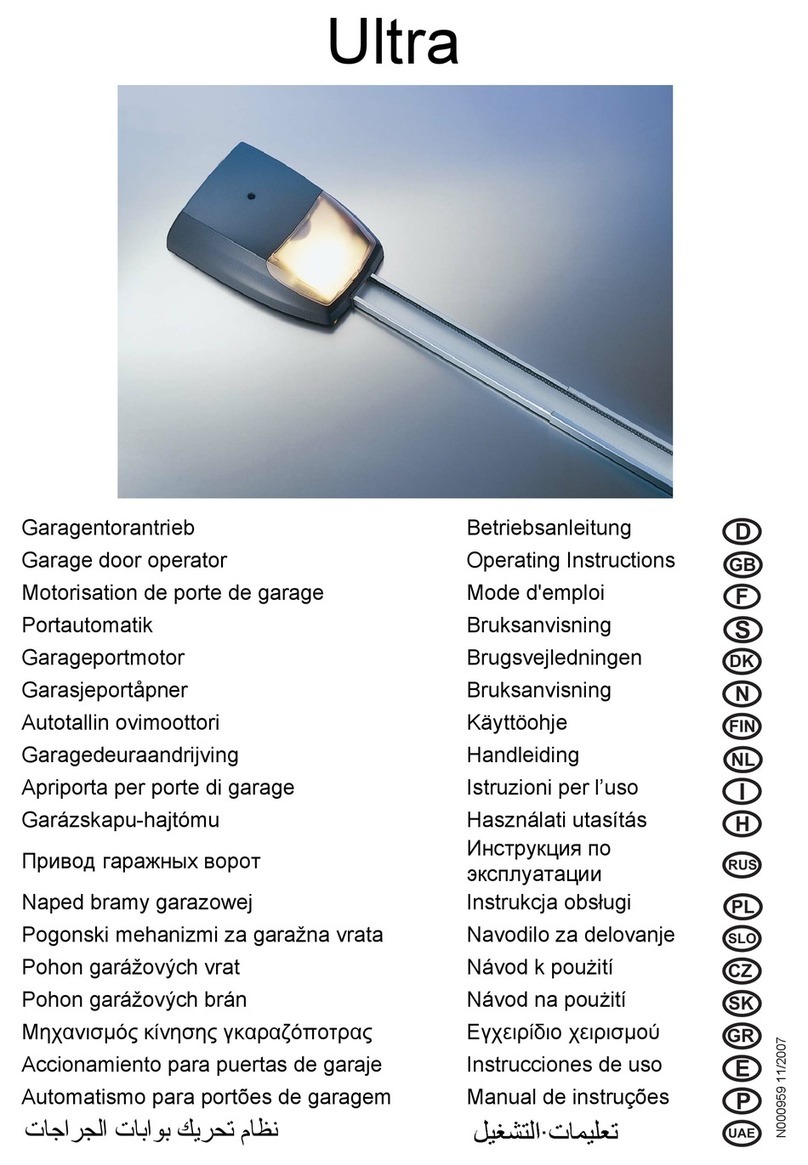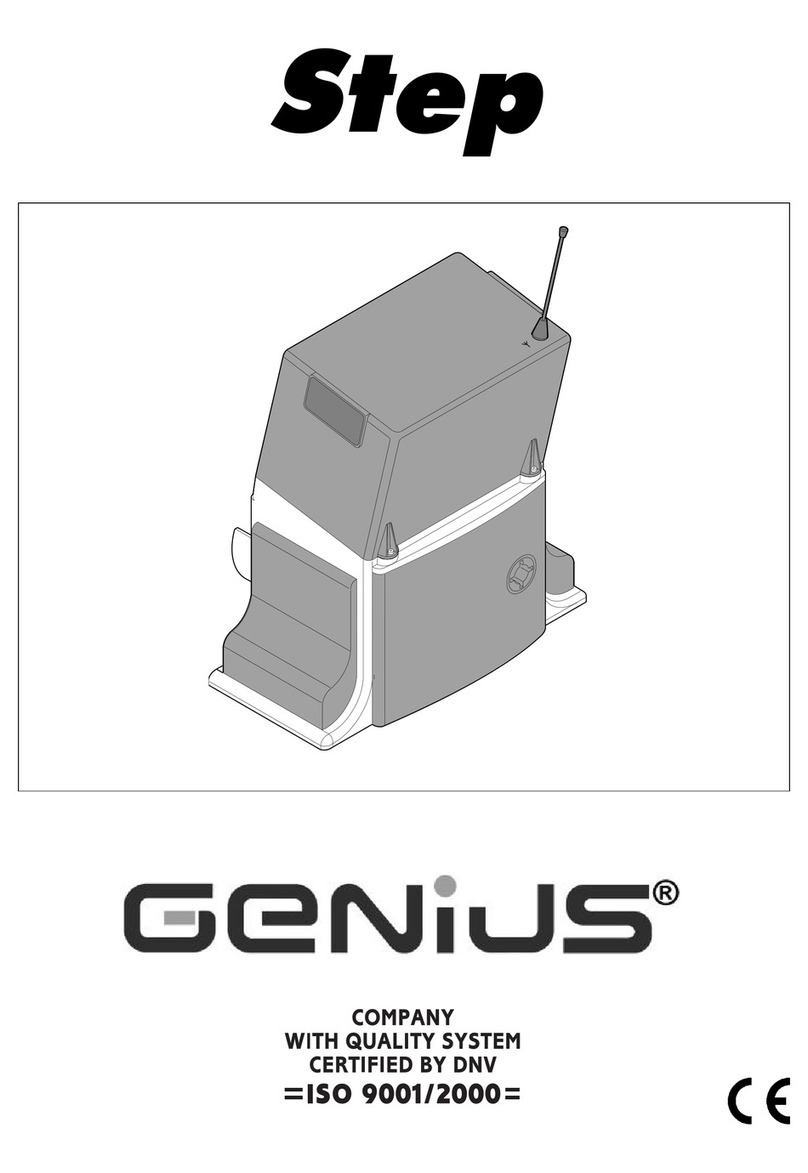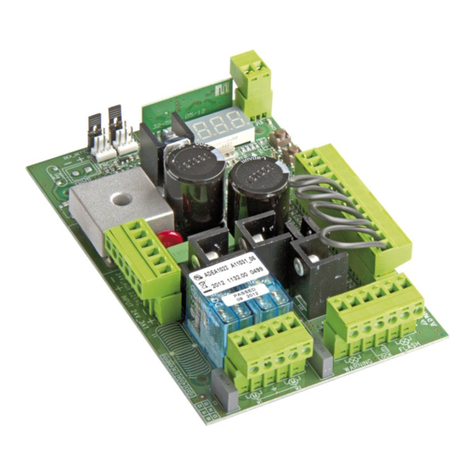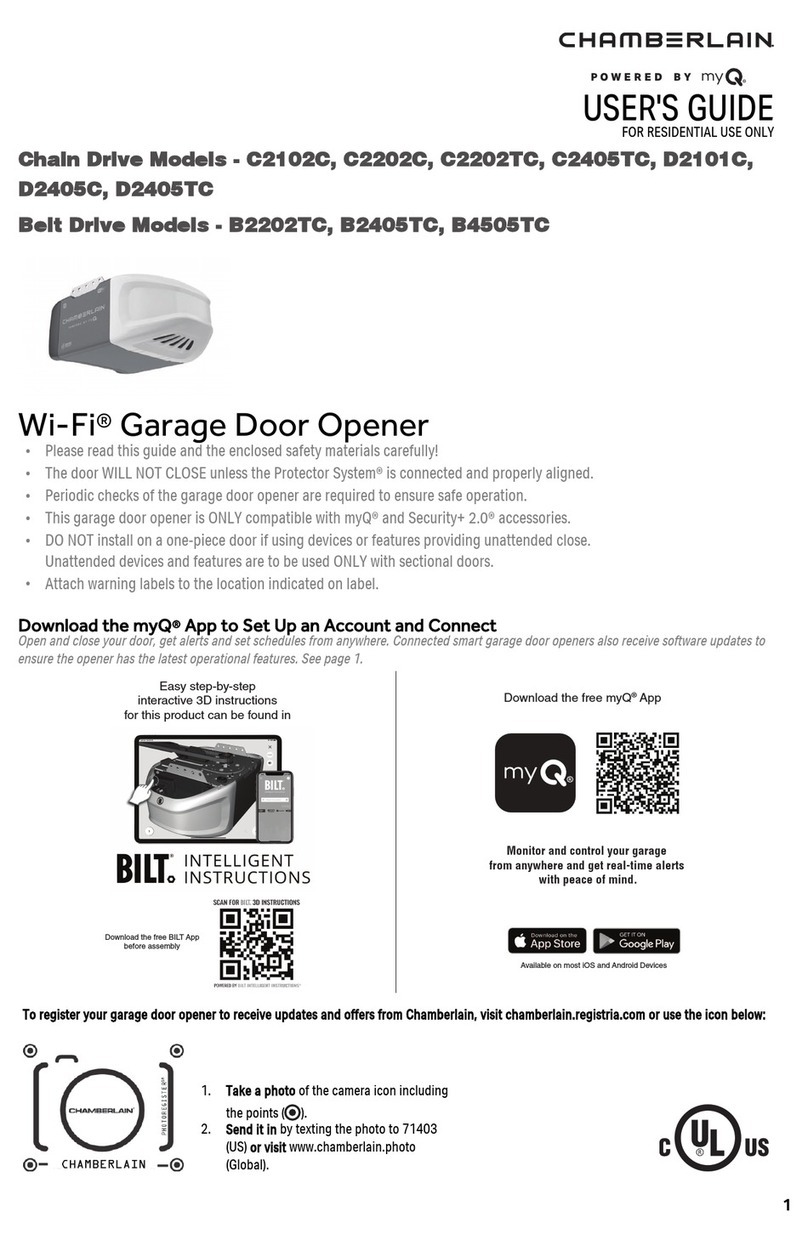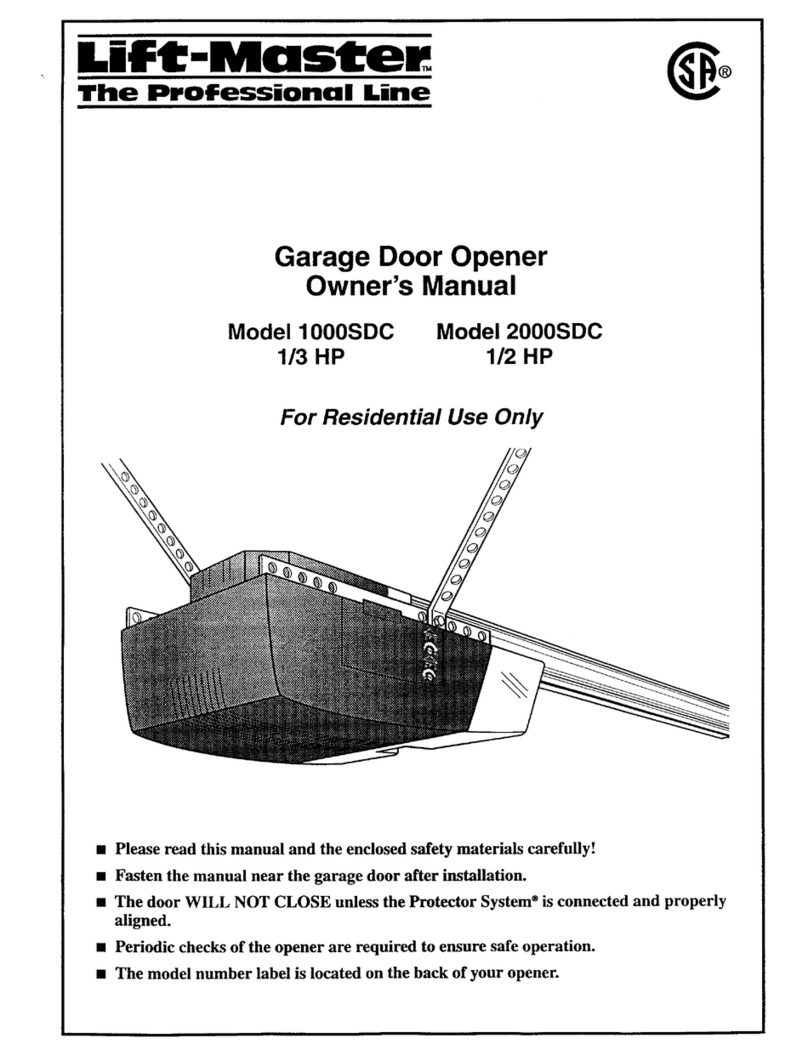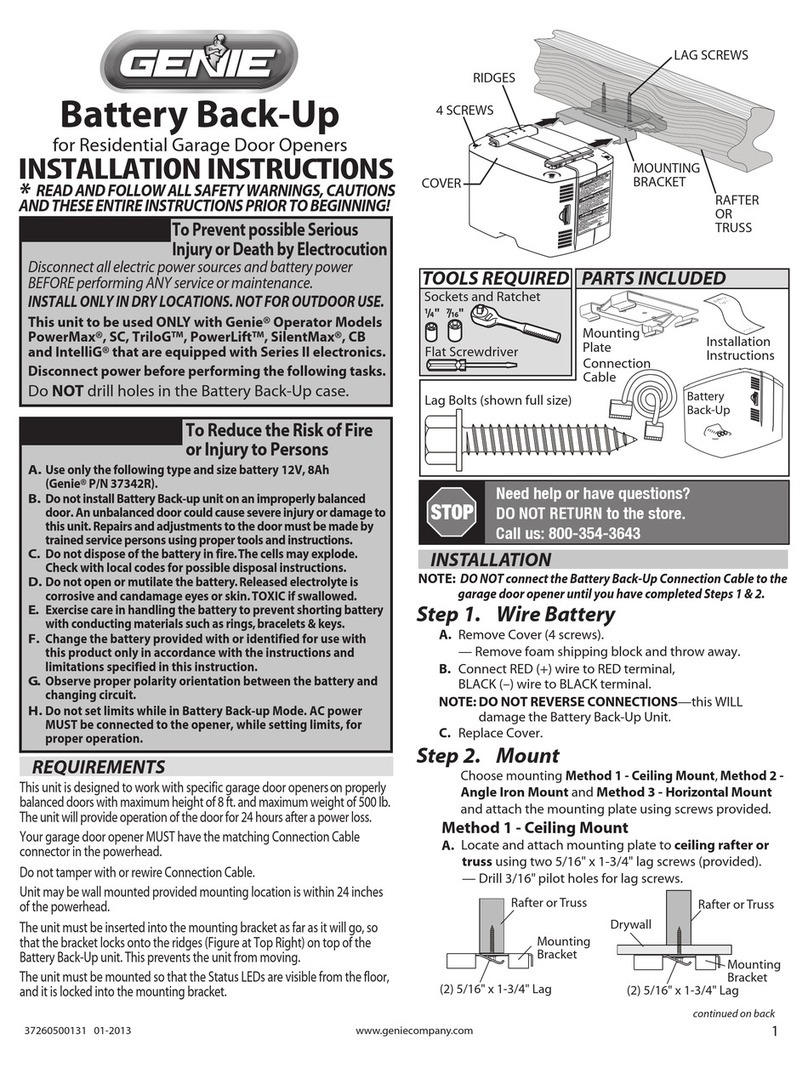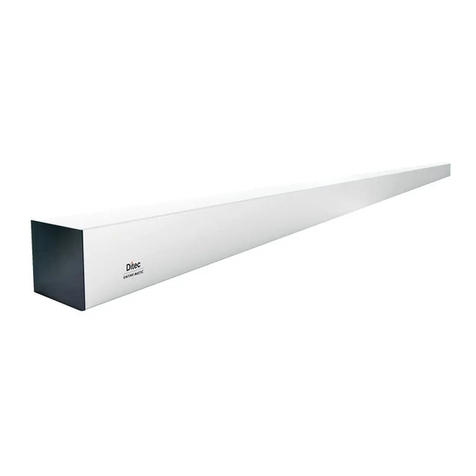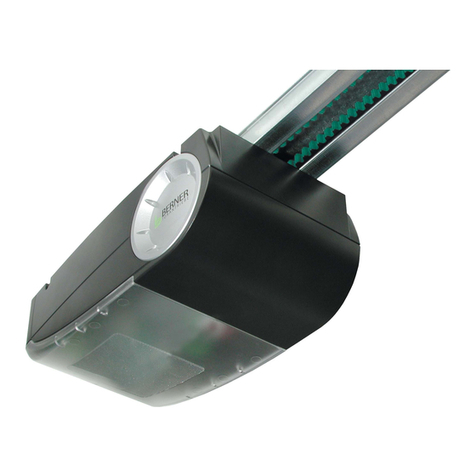Merik 511MM FS2 User manual

Owner’s Manual
■Please read this manual and the enclosed safety materials carefully!
■Fasten the manual near the garage door after installation.
■Periodic checks of the opener are required to ensure safe operation.
■The model number label is located on the front panel of your opener.
®
GARAGE DOOR OPENER
Model 511MM FS2
For Residential Use Only

2
Introduction 2-8
Safety symbol and signal word review....................... 2
Preparing your garage door ....................................... 3
Tools needed.............................................................. 3
Planning ................................................................. 4-6
Carton inventory......................................................... 7
Hardware inventory .................................................... 8
Assembly 9-15
Assemble T-rail & attach the pulley bracket.......... 9-10
Install the trolley ........................................................11
Fasten the T-rail to the motor unit............................ 12
Install the chain/cable and chain spreader.......... 13-14
Tighten the chain and cable ..................................... 15
Installation 15-28
Installation safety instructions .................................. 15
Determine the header bracket location ............... 16-17
Install the header bracket......................................... 18
Attach the T-rail to the header bracket..................... 19
Position the opener .................................................. 20
Hang the opener....................................................... 21
Install the door control.............................................. 22
Install the light .......................................................... 23
Attach the emergency release rope and handle ...... 23
Electrical requirements............................................. 24
Fasten the door bracket ...................................... 25-26
Connect the door arm to the trolley..................... 27-28
Adjustment 29-31
Adjust the travel limits .............................................. 29
Adjust the force ........................................................ 30
Test the safety reversal system................................ 31
Operation 32-35
Operation safety instructions.................................... 32
Using your garage door opener ............................... 32
Using the wall-mounted door control........................ 33
To open the door manually....................................... 33
Care of your garage door opener............................. 34
Having a problem? ..............................................34-35
Programming 36-37
To add or reprogram an additional
hand-held remote control ......................................... 36
To erase all codes .................................................... 36
3-button remotes ...................................................... 36
To add, reprogram or change a Keyless Entry PIN . 37
Repair Parts 38
Accessories 39
Service Numbers 40
Warranty 40
TABLE OF CONTENTS
When you see these Safety Symbols and Signal Words on
the following pages, they will alert you to the possibility of
serious injury or death if you do not comply with the
warnings that accompany them. The hazard may come
from something mechanical or from electric shock. Read
the warnings carefully.
When you see this Signal Word on the following pages, it
will alert you to the possibility of damage to your garage
door and/or the garage door opener if you do not comply
with the cautionary statements that accompany it. Read
them carefully.
Mechanical
Electrical
INTRODUCTION
Safety Symbol and Signal Word Review
This garage door opener has been designed and tested to offer safe service provided it is installed, operated,
maintained and tested in strict accordance with the instructions and warnings contained in this manual.

3
Pliers
Wire Cutters
Claw Hammer
Hack Saw
Screwdriver Adjustable End Wrench
1/2" and 7/16" Sockets
and Wrench
Drill
Tape Measure
2
1
Stepladder
Pencil
3/16", 5/16" and
5/32" Drill Bits
Carpenter’s
Level (Optional)
To prevent damage to garage door and opener:
• ALWAYS disable locks before installing and operating the
opener.
• ONLY operate garage door opener at 120V, 60 Hz to avoid
malfunction and damage.
To prevent possible SERIOUS INJURY OR DEATH:
• ALWAYS call a trained door systems technician if garage
door binds, sticks, or is out of balance. An unbalanced
garage door may NOT reverse when required.
• NEVER try to loosen, move or adjust garage door, door
springs, cables, pulleys, brackets or their hardware, ALL of
which are under EXTREME tension.
• Disable ALL locks and remove ALL ropes connected to
garage door BEFORE installing and operating garage door
opener to avoid entanglement.
Preparing your garage door
Before you begin:
• Disable locks.
• Remove any ropes connected to garage door.
• Complete the following test to make sure your garage
door is balanced and is not sticking or binding:
1. Lift the door about halfway as shown. Release the
door. If balanced, it should stay in place, supported
entirely by its springs.
2. Raise and lower the door to see if there is any
binding or sticking.
If your door binds, sticks, or is out of balance, call a
trained door systems technician.
Tools needed
During assembly, installation and adjustment of the
opener, instructions will call for hand tools as illustrated
below.
Sectional Door
One-Piece Door

Safety Reversing Sensor
Support bracket &
fastening hardware
is required.
See page 21.
— — — — — — — —
Header Wall
FINISHED CEILING
Torsion
Spring
Extension
Spring
OR
Safety Reversing Sensor
Gap between floor
and bottom of door
must not exceed 6 mm.
Access
Door
Wall-
mounted
Door
Control
Horizontal and vertical reinforcement
is needed for lightweight garage doors
(fiberglass, steel, aluminum, door with
glass panels, etc.). See page 25 for details.
Motor unit
Slack in chain tension
is normal when
garage door is closed
(Optional Accessory)
(Optional Accessory)
Vertical
Centerline of
Garage Door
4
SECTIONAL DOOR INSTALLATION
Planning
Identify the type and height of your garage door. Survey
your garage area to see if any of the conditions below
apply to your installation. Additional materials may be
required. You may find it helpful to refer back to this page
and the accompanying illustrations as you proceed with
the installation of your opener.
Depending on your requirements, there are several
installation steps which may call for materials or hardware
not included in the carton.
• Installation Step 1 – Look at the wall or ceiling above
the garage door. The header bracket must be securely
fastened to structural supports.
• Installation Step 5 – Do you have a finished ceiling in
your garage? If so, a support bracket and additional
fastening hardware may be required.
• Do you have an access door in addition to the garage
door? If not, Model 7702CBOutside Quick Release is
required. See Accessories page.
Cable Pulley
Bracket
Header
Bracket Trolley
Straight
Door
Arm Emergency
Release
Rope & Handle
Door Bracket
Garage
Door
Curved
Door
Arm
Garage
Door
Spring
Header
Wall
CLOSED POSITION
Rail
Chain
• Look at the garage door where it meets the floor. Any
gap between the floor and the bottom of the door must
not exceed 6 mm. Otherwise, the safety reversal system
may not work properly. See Adjustment Step 3. Floor or
door should be repaired.
SECTIONAL DOOR INSTALLATIONS
• Do you have a steel, aluminum, fiberglass or glass panel
door? If so, horizontal and vertical reinforcement is
required (Installation Step 10).
• The opener should be installed above the center of the
door. If there is a torsion spring or center bearing plate in
the way of the header bracket, it may be installed within
1.2 m to the left or right of the door center. See
Installation Steps 1 and 10.

5
Planning (Continued)
ONE-PIECE DOOR INSTALLATIONS
• Generally, a one-piece door does not require
reinforcement. If your door is lightweight, refer to the
information relating to sectional doors in Installation
Step 10.
• Depending on your door’s construction, you may need
additional mounting hardware for the door bracket
(Step 10).
Without a properly working safety reversal system, persons
(particularly small children) could be SERIOUSLY INJURED or
KILLED by a closing garage door.
• The gap between the bottom of the garage door and the floor
MUST NOT exceed 6 mm. Otherwise, the safety reversal
system may not work properly.
• The floor or the garage door MUST be repaired to eliminate
the gap.
Safety
Reversing Sensor
(Optional Accessory)
FINISHED CEILING
Support bracket
& fastening
hardware is required.
See page 21.
Slack in Chain Tension
is Normal When
Garage Door is Closed
Safety
Reversing Sensor
(Optional Accessory)
Header
Wall
Access
Door
Gap between floor and bottom
of door must not exceed 6 mm.
Wall-mounted
Door
Control
Motor Unit
ONE-PIECE DOOR WITHOUT TRACK
CLOSED POSITION
Access
Door
Gap between floor
and bottom of door
must not exceed 6 mm.
Safety Reversing
Sensor
Wall-
Mounted
Door
Control
Cable
Pulley Bracket
Door
Bracket
Straight
Door
Arm
Trolley
Header
Wall
Rail
Garage
Door
Emergency Release
Rope & Handle
Chain
Header
Bracket
Curved
Door Arm
Safety Reversing
Sensor
(Optional Accessory)
(Optional Accessory)
ONE-PIECE DOOR WITH TRACK
CLOSED POSITION
Cable
Pulley Bracket
Header
Bracket
Trolley
Straight
Door
Arm
Emergency
Release
Rope & Handle
Door
Bracket
Curved
Door
Arm
Header
Wall
Rail
Garage
Door

6
Safety Reversing Sensor
Safety Reversing Sensor
(Optional Accessory)
(Optional Accessory)
Header Wall
Safety Reversing Sensor
Safety Reversing Sensor
(Optional Accessory)
(Optional Accessory)
SLIDING GATE INSTALLATION
SWINGING GATE INSTALLATION
Planning (Continued)
GATE INSTALLATIONS
• It is recommended that you attach fine mesh or
screening across the inside of swinging or sliding gates
in order to prevent intruders from reaching through the
bars and releasing the trolley from the door arm or
pressing the door control button.
• The opener must be protected from rain and/or
moisture.
Without a properly working safety reversal system, persons
(particularly small children) could be SERIOUSLY INJURED or
KILLED by a closing gate.
• Activate gate ONLY when the gate is in full view and free
from any obstructions.
• ALWAYS keep gate in sight until completely closed. NEVER
permit anyone to cross the path of the moving gate.
• ALWAYS keep gate in good repair and make sure it moves
freely. An improperly maintained gate may NOT reverse when
required and could result in SEVERE PERSONAL INJURY or
DEATH.

7
41B2616
Cable Pulley
Bracket
41B4494-1
2-Conductor Bell Wire
White & White/Red
41A3489
Trolley
41A4353
Header Bracket
178B35
Curved Door
Arm Section
178B34
Straight Door
Arm Section
Safety Labels
and
Literature
12B350
Hanging Brackets
U
P
CEI
LIN
G M
O
U
NT ONL
Y
41A5047
Door Bracket
973-315MK
SECURITY✚®
Multi-function
Remote Control (2)
1B3117
T-rail
Center Section
OT G R
A AG
E DOO
R
183B110
T-rail End Section (each)
41A4208
Chain Spreader
and Screws
41A3473-2
Chain/Cable
Dispensing Carton
41A5577-1
Lighted Door
Control Button
108D79
Motor Unit and Light Lens
Your garage door opener is packaged in one carton which
contains the motor unit and the parts illustrated below.
Note that accessories will depend on the model
purchased. If anything is missing, carefully check the
packing material.
Parts may be stuck in the foam. Hardware for assembly
and installation is shown on the next page. Save the
carton and packing material until installation and
adjustment is complete.
Carton Inventory

Hardware Inventory
Separate all hardware and group as shown below for the assembly and installation procedures.
8
Hex Bolt
5/16"-18x7/8" (4)
Screw
6ABx1-1/4" (2)
Lock Washer
5/16" (4)
Nut
5/16"-18 (4)
Clevis Pin
5/16"x2-3/4" (1)
NOTICE
Handle
Insulated
Staples (10)
Assembly Hardware 41A3534
Installation Hardware 41A3475-30
Drywall Anchors (2)
Clevis Pin
5/16"x1" (2)
Rope
Lock Nut
1/4"-20x7/16" (12)
Nut
5/16"-18 (5)
Washered Bolt
5/16"-18x1/2" (2)
(mounted in opener)
Carriage Bolt
1/4"-20x1/2" (12)
Hex Bolt
5/16"-18x7/8" (3)
Master Link (2)
Ring Fastener (3)
Trolley
Threaded Shaft (1)
Lock Washer
5/16" (4)
Lag Screw
5/16"-9x1-5/8" (4)
Self-Threading Screw
1/4"-14x5/8" (2)

9
ASSEMBLY STEP 1
For Sectional and
One-Piece Doors ONLY
Assemble the T-Rail and
Attach the Cable Pulley Bracket
To avoid installation difficulties, do not run the garage
door opener until instructed to do so.
1. Place the 3 T-rail sections on a flat
surface for assembly. The end sections
are identical. The center section must be
positioned with the braces against the
end sections as shown. Make sure the
"directional arrow"on the center section
is pointing toward the front (to door).
Study the illustration carefully.
2. Bolt rail sections together with the
hardware illustrated and from the
direction indicated. (When assembled,
T-rail has a front-to-back position as shown.)
NOTE: If T-rail is not assembled exactly as shown,
trolley will not travel smoothly along length of rail or it
will hit against nuts.
3. Position the cable pulley bracket on the front end of the
T-rail as shown. Fasten securely with the hardware
provided.
NOTE: When tightening the bolts be sure to keep
bracket parallel to the rail. Otherwise, the rail may bow
when the opener is operated.
Lock Nut
1/4"-20
Carriage Bolts
1/4"-20x1/2"
Hex Bolt
5/16"-18x7/8"
Nut
5/16"-18 Lock Washer
5/16"
HARDWARE
SHOWN ACTUAL SIZE
Rail
(Center Section)
1/4'' Lock Nut
RAIL FRONT
(TO DOOR)
Cable pulley bracket
attaches to FRONT
END of Rail
Rail
(End Section)
RAIL BACK
(TO OPENER)
Rail
(End Section)
Carriage Bolt
1/4"-20x1/2"
Brace
Brace
Square Carriage
Bolt Holes
OT G RA GA D
E OOR
Hex Bolts
5/16"-18x7/8"
dengilAeBtsuMlia
&tekcarBliaR
Lock Washer
5/16"
Nut
5/16"
Cable Pulley
Bracket
R
Hex Bolts
5/16"-18x7/8"
dengilAeBtsuMlia
&tekcarBliaR
Lock Washer
5/16"
Nut
5/16"
Cable Pulley
Bracket
R
11 mm Socket Wrench
13 mm Socket Wrench

10
ASSEMBLY STEP 1
For Sliding and Swinging Gates ONLY
Assemble the T-Rail and
Attach the Cable Pulley Bracket
To avoid installation difficulties, do
not run the garage door opener until
instructed to do so.
1. Place the 3 T-rail sections on a flat
surface for assembly. The end sections
are identical. Make sure the “arrow label”
on the center section is pointing in the
direction shown in the illustration.
2. Connect the center section and the 1/4"
lock nuts to the end sections from the
same side, as shown.
NOTE: If T-rail is not assembled exactly as shown,
trolley will not travel smoothly along length of rail or it
will hit against nuts.
3. Insert the carriage bolts from the opposite side of the
end sections. Tighten the nuts. When assembled, T-rail
has a front-to-back position as shown.
4. Position the cable pulley bracket on the front end of the
T-rail as shown. Fasten securely with the hardware
provided.
NOTE: When tightening the bolts be sure to keep
bracket parallel to the rail. Otherwise, the rail may bow
when the opener is operated.
Lock Nut
1/4"-20
Carriage Bolts
1/4"-20x1/2"
Hex Bolt
5/16"-18x7/8"
Nut
5/16"-18 Lock Washer
5/16"
HARDWARE
SHOWN ACTUAL SIZE
Rail
(Center Section)
1/4'' Lock Nut
Cable pulley bracket
attaches to this
end of rail.
Rail
(End Section)
Carriage Bolt
1/4"-20x1/2"
Brace
Square Carriage
Bolt Holes
ROODEGARAGOT
AWAY FROM
OPENER
Brace
Rail
(End Section)
Rail connects to
opener at this end. Tuerca de 1/4" Riel en "T"
(Sección Extrema)
El sostén de la polea
del cable se fija a este
extremo del riel en "T".
Hex Bolts
5/16"-18x7/8"
Cable Pulley
Bracket
dengilAeBtsuMlia
&tekcarBliaR
Lock Washer
5/16"
Nut
5/16"
R
13 mm Socket Wrench
11 mm Socket Wrench
Hex Bolts
5/16"-18x7/8"
Cable Pulley
Bracket
dengilAeBtsuMlia
&tekcarBliaR
Lock Washer
5/16"
Nut
5/16"
R

ASSEMBLY STEP 2
For Sectional and One-Piece Doors Only
Install the Trolley
• Attach the trolley threaded shaft to the trolley with the
lock washer and nuts as shown.
• As a temporary stop, insert a screwdriver into the hole
in the front end of the T-rail.
• Slide the trolley assembly along the rail to the
screwdriver stop.
NOTE: If trolley hits against any nuts on the
T-rail, the bolts and nuts were attached from
the wrong side and must be repositioned.
Review Assembly Step 1.
Trolley
Threaded
Shaft
Lock Washer
5/16"
Outer Nut
5/16"-18
Inner Nut
5/16"-18
Trolley
Trolley
Temporary Stop
Screwdriver
Lock Washer
5/16" Nut
5/16"-18
HARDWARE SHOWN ACTUAL SIZE
ASSEMBLY STEP 2
For Sliding and Swinging Gates Only
Install the Trolley
• Attach the trolley threaded shaft to the trolley with the
lock washer and nuts as shown.
• Insert a hex bolt into the hole in the front end of the
T-rail.
• Slide the trolley assembly along the rail until it rests
against the hex bolt (trolley stop).
NOTE: If trolley hits against any nuts on the T-rail,
the bolts and nuts were attached from the wrong
side and must be repositioned. Review
Assembly Step 1.
Trolley
Threaded
Shaft
Lock Washer
5/16"
Outer Nut
5/16"-18
Inner Nut
5/16"-18
Trolley
Hex Bolt
Trolley Stop
Hex Bolt
5/16"-18x7/8"
Nut
5/16"-18
Lock Washer
5/16"
Cable Pulley
Bracket
Nut
5/16"-18 Lockwasher
5/16"
Hex Bolt
5/16"-18x7/8"
HARDWARE SHOWN ACTUAL SIZE
11

12
ASSEMBLY STEP 3
Fasten the T-Rail to the Motor Unit
• Place the opener on packing material to protect the
cover. For convenience, put a support under the cable
pulley bracket.
• Remove the two 5/16"-18x1/2"washered bolts mounted
in the top of the motor unit.
• Align the holes in the back section of the T-rail with the
holes in the motor unit.
• Fasten the rail with the two washered bolts previously
removed. Tighten securely. Remember to use only
these bolts! Any other bolts will cause serious
damage to the opener.
• Insert a 5/16"-18x7/8"hex bolt into the cover protection
bolt hole in the T-rail as shown. Tighten securely with a
5/16"lock washer and nut.
NOTE: This bolt prevents trolley over-travel. Keep a 38 mm
minimum between the trolley and this bolt when adjusting
travel limits (see page 29).
• Attach chain spreader with #8x1"hex screws and
washers as shown.
Washered Bolt
5/16"-18x1/2"
Rail
(Back
Section)
Cover
Protection
Bolt Hole
Nut
5/16"-18
HexBolt
5/16"-18x7/8"
Lock Washer
5/16"
USE ONLY THIS
TYPE AND SIZE
BOLT
Chain
Spreader
#8x1"
HexScrews
Washers
Nut
5/16"-18 Lock Washer
5/16"
Hex Bolt
5/16"-18x7/8"
HARDWARE SHOWN ACTUAL SIZE
To avoid serious damage to opener, ONLY use bolts/fasteners
mounted in top of motor unit.

ASSEMBLY STEP 4
For Sectional and One-Piece Doors Only
Install the Chain/Cable
1. Pull the cable loop from the
carton and fasten it to the
trolley with a master link
from the hardware bag
(Figure 1).
• Push pins of master link
bar through cable loop and
hole in front end of trolley.
• Push master link cap over
pins and past pin notches.
• Slide clip-on spring over cap and onto pin notches
until both pins are securely locked in place.
2. With the trolley against the screwdriver, dispense the
cable around the pulley.
3. Continue along the rail and around the motor unit
sprocket (Figure 2). Proceed back around the correct
groove in the chain spreader (Figure 3). The sprocket
teeth must engage the chain.
4. Use the second master link to connect the chain to
the flat end of the shaft (Figure 1). Check to make
sure the chain is not twisted.
5. Remove the screwdriver.
13
To avoid possible SERIOUS INJURY to fingers from moving
garage door opener:
• ALWAYS keep hand clear of sprocket while operating opener.
• Securely attach sprocket cover BEFORE operating.
Motor Unit
Sprocket
Install Chain
In This Direction
Chain
Spreader
Figure 2
Cable
Pulley
Cable
Loop
Master
Link Bar
Master Link
Clip-On Spring
Pin
Pin
Notch
Chain
Flat end
of Trolley
Threaded
Shaft
Master Link Cap
Master
Link Cap
Master Link
Clip-On Spring
Install Chain & Cable
In This Direction
Figure 1
Leave Chain
& Cable
Inside Carton to
Prevent Kinking
Keep Chain
Taut When Dispensing
6-Tooth
Sprocket
Opener
Mounting Plate
Chain
Spreader
8-Tooth
Sprocket
Opener
Mounting Plate
Chain
Spreader
Figure 3
One-Piece Doors
6- Tooth Sprocket Application
Sectional Doors
8-Tooth Sprocket Application
(6-tooth sprocket can be used if slower travel speed is
desired.)

14
ASSEMBLY STEP 4
For Sliding and Swinging Gates Only
Install the Chain/Cable
1. Pull the cable loop from the
carton and fasten it to the
trolley with a master link from
the hardware bag (Figure 1).
• Push pins of master link bar
through cable loop and hole
in front end of trolley.
• Push master link cap over
pins and past pin notches.
• Slide clip-on spring over cap and onto pin notches until
both pins are securely locked in place.
2. To prevent the trolley from jamming against the opener
during operation, position trolley 5 to 15 cm from the
stop hole as shown. Then dispense the chain around
the opener sprocket (Figure 1). Make sure the sprocket
teeth engage the chain.
• Proceed around to the pulley bracket and forward to
the threaded trolley shaft.
3. Use the second master link to connect the chain to the
flat end of the shaft (Figure 1). Check to make sure the
chain is not twisted.
To avoid possible SERIOUS INJURY to fingers from moving
opener:
• ALWAYS keep hand clear of sprocket while operating opener.
• Securely attach sprocket cover BEFORE operating.
Leave Chain
& Cable
Inside Carton to
Prevent Kinking
Keep Chain
Taut When Dispensing
Sprocket
Motor Unit
Mounting
Plate
Install Chain
and Cable
in this Direction
Cable Loop
Master
Link Pin
Master Link
Clip-On Spring
Master Link
Clip-On Spring
Flat End
of Trolley
Trolley Pin Notch
Flat End of
Threaded Shaft
Master
Link Cap
Cable
Rail
Master
Link Cap
Chain
Chain Link
Trolley Stop
(Hex Bolt)
mc51-5
Pin Notch
Master
Link
Pin
Figure 1

15
ASSEMBLY STEP 5
Tighten the Chain and Cable
• Spin the inner nut and lock washer down the trolley
threaded shaft, away from the trolley.
• To tighten the chain, turn outer nut in the direction
shown. AS YOU TURN THE NUT, KEEP THE CHAIN
FROM TWISTING.
• When the chain is approximately 13 mm above the base
of the T-rail at its midpoint, re-tighten the inner nut to
secure the adjustment.
Sprocket noise can result if chain is either too loose
or too tight.
NOTE: When installation is complete, you may notice
some chain droop with the door closed. This is normal. If
the chain returns to the position shown when the door is
open, do not re-adjust the chain.
NOTE: During future maintenance, ALWAYS pull the
emergency release handle to disconnect trolley before
adjusting chain.
You have now finished assembling your garage door
opener. Please read the following warnings before
proceeding to the installation section.
Lock
Washer
To Tighten Outer Nut
Inner Nut
Chain
Base of Rail
13 mm
To Tighten
Inner Nut
Outer Nut
IMPORTANT INSTALLATION INSTRUCTIONS
1. READ AND FOLLOW ALL INSTALLATION WARNINGS
AND INSTRUCTIONS.
2. Install garage door opener ONLY on properly balanced
and lubricated garage door. An improperly balanced door
may NOT reverse when required and could result in
SEVERE INJURY or DEATH.
3. ALL repairs to cables, spring assemblies and other
hardware MUST be made by a trained door systems
technician BEFORE installing opener.
4. Disable ALL locks and remove ALL ropes connected to
garage door BEFORE installing opener to avoid
entanglement.
5. Install garage door opener 2.1 m or more above floor.
6. Mount the emergency release within reach, but at least
1.8 m above the floor and avoiding contact with vehicles
to avoid accidental release.
7. NEVER connect garage door opener to power source
until instructed to do so.
8. NEVER wear watches, rings or loose clothing while
installing or servicing opener. They could be caught in
garage door or opener mechanisms.
9. Install wall-mounted garage door control:
• within sight of the garage door
• out of reach of children at minimum height of 1.5 m
• away from ALL moving parts of the door.
10. Place entrapment warning label on wall next to garage
door control.
11. Place manual release/safety reverse test label in plain
view on inside of garage door.
12. Upon completion of installation, test safety reversal
system. Door MUST reverse on contact with a 38 mm
obstruction on the floor.
To reduce the risk of SEVERE INJURY or DEATH:
WARNING
INSTALLATION

16
INSTALLATION STEP 1
Determine the Header Bracket
Location
Installation procedures vary according to garage door
types. Follow the instructions which apply to your door.
If your door is a canopy or dual-track style garage door, a
door arm conversion kit is REQUIRED. Follow the
installation instructions included with the replacement door
arm sectional.
SECTIONAL DOOR AND
ONE-PIECE DOOR WITH TRACK
1. Close the door and mark the inside vertical centerline of
the garage door.
2. Extend the line onto the header wall above the door.
You can fasten the header bracket within 1.2 m of
the left or right of the door center only if a torsion
spring or center bearing plate is in the way; or you
can attach it to the ceiling (see page 17) when
clearance is minimal. (It may be mounted on the wall
upside down if necessary, to gain approximately
1 cm .)
If you need to install the header bracket on a 38 mm
board (on wall or ceiling), use lag screws (not provided)
to securely fasten the 38 mm board to structural
supports as shown here and on page 17.
3. Open your door to the highest point of travel as shown.
Draw an intersecting horizontal line on the header wall
5 cm above the high point. This height will provide travel
clearance for the top edge of the door.
Proceed to Step 2, page 18.
To prevent possible SERIOUS INJURY or DEATH:
• Header bracket MUST be RIGIDLY fastened to structural
support on header wall or ceiling, otherwise garage door
might NOT reverse when required. DO NOT install header
bracket over drywall.
• Concrete anchors MUST be used if mounting header bracket
or 38 mm board into masonry.
• NEVER try to loosen, move or adjust garage door, springs,
cables, pulleys, brackets, or their hardware, ALL of which are
under EXTREME tension.
• ALWAYS call a trained door systems technician if garage
door binds, sticks, or is out of balance. An unbalanced
garage door might NOT reverse when required.
Finished
Ceiling
Header
Wall
38 mm
Board Structural
Supports
Vertical
Centerline of
Garage Door
Header
Wall
Ceiling
SECTIONAL DOOR
WITH CURVED TRACK
Track
Highest Point
of Travel
Door
Header
Wall
Door Track
Jamb
Hardware
Highest Point
of Travel
ONE-PIECE DOOR
WITH HORIZONTAL
TRACK & JAMB
HARDWARE
Highest Point
of Travel
Door
Track
Garage
Exterior
Track
Header
Wall
Highest Point
of Travel
Door
Track
CANOPY ONE-PIECE
DOOR WITH
VERTICAL TRACK
Header
Wall
ONE-PIECE DOOR
WITH HORIZONTAL &
VERTICAL TRACK

EXAMPLE
Distance from top of door
(at highest point of travel)to floor ......... 234 cm
Actual height of door ............................ -224 cm
Remainder............................................... 10 cm
Add ........................................................ +20 cm
Bracket height on header wall............... =30 cm
(Measure UP from top of CLOSED door.)
Proceed to Step 2, page 18.
17
Header Wall
Vertical
Centerline
of Garage
Door
2x4
Unfinished
Ceiling
2x4
OPTIONAL
CEILING MOUNT
FOR
HEADER BRACKET
Structural
Supports
ONE-PIECE DOOR WITHOUT TRACK
1. Close the door and mark the inside vertical centerline of
your garage door. Extend the line onto the header wall
above door, as shown.
If headroom clearance is minimal, you can install the
header bracket on the ceiling. (See page 18).
If you need to install the header bracket on a 38 mm
board (on wall or ceiling), use lag screws (not provided)
to securely fasten the 38 mm board to structural
supports as shown.
2. Open your door to the highest point of travel as shown.
Measure the distance from the top of the door to the
floor. Subtract the actual height of the door. Add 20 cm
to the remainder. (See Example).
3. Close the door and draw an intersecting horizontal line
on the header wall at the determined height.
NOTE: If the total number of centimeters exceeds the
height available in your garage, use the maximum height
possible, or refer to page 18 for ceiling installation.
Door
Highest Point
of Travel
Header Wall
Pivot
Distance
Floor
One-piece door without track:
pivot hardware
Header Wall
Highest Point
of Travel
Door
Floor
Distance
Jamb
Hardware
One-piece door without track:
jamb hardware

18
INSTALLATION STEP 2
Install the Header Bracket
You can attach the header bracket either to the wall above
the garage door, or to the ceiling. Follow the instructions
which will work best for your particular requirements. Do
not install the header bracket over drywall. If installing
into masonry, use concrete anchors (not provided).
WALL HEADER BRACKET INSTALLATION
• Center the bracket on the vertical centerline with the
bottom edge of the bracket on the horizontal line as
shown (with the arrow pointing toward the ceiling).
• Mark the vertical set of bracket holes (do not use the
holes designated for ceiling mount). Drill 5 mm pilot
holes and fasten the bracket securely to a structural
support with the hardware provided.
Lag Screw
5/16"-9x1-5/8"
HARDWARE SHOWN ACTUAL SIZE
Lag Screws
5/16"x9x1-5/8"
Highest Point of
Garage Door Travel
Vertical
Centerline of
Garage Door
Header
Wall
Garage
Door
UP
CEILING MOUNT ONLY
Wall Mounting Holes
Optional
Wall Mounting Holes
The nail hole is for
positioning only.
You must use lag screws
to mount the header bracket.
UP
CEILINGMOUNTONLY
Door Spring
Header
Bracket
38 mm
Board
Vertical Centerline
of Garage Door
UP
CEILING MOUNT ONLY
Ceiling Mounting Holes
The nail hole is for
positioning only.
You must use lag screws
to mount the header bracket.
UP
Lag Screws
5/16"x9x1-5/8"
Garage Door
Vertical Centerline
of Garage Door
Header Wall
– Finished Ceiling –
Header
Bracket
15 cm Maximum
Vertical
Centerline of
Garage Door
Door
Spring
CEILING HEADER BRACKET INSTALLATION
• Extend the vertical centerline onto the ceiling as shown.
• Center the bracket on the vertical mark, no more than
15 cm from the wall. Make sure the arrow is pointing
toward the wall. The bracket can be mounted flush
against the ceiling when clearance is minimal.
• Mark the side holes. Drill 5 mm pilot holes and fasten
bracket securely to a structural support with the
hardware provided.

Clevis Pin
5/16"x2-3/4" Ring Fastener
HARDWARE SHOWN ACTUAL SIZE
Header Bracket
Chain Pulley
Bracket
Temporary
Support
Header Wall
Garage
Door
Rail
Clevis Pin
5/16"x2-3/4"
Ring Fastener
Header Bracket
Chain
Pulley
Bracket
Rail
19
INSTALLATION STEP 3
Attach the T-Rail to the Header Bracket
• Position the opener on the garage floor below the
header bracket. Use packing material as a protective
base.
NOTE: If the door spring is in the way you’ll need help.
Have someone hold the opener securely on a temporary
support to allow the rail to clear the spring.
• Position the rail bracket against the header bracket.
• Align the bracket holes and join with a clevis pin
as shown.
• Insert a ring fastener to secure.

20
ONE-PIECE DOOR WITHOUT TRACK
A 38 mm board is convenient for setting an ideal door-to-
T-rail distance.
• With the door fully open and parallel to the floor,
measure the distance from the floor to the top of the
door.
• Using a stepladder as a support, raise the top of the
opener to this height.
• The top of the door should be level with the top of the
motor unit. Do not position the opener more than 5 cm
above this point.
INSTALLATION STEP 4
Position the Opener
Follow instructions which apply to your door type as
illustrated.
SECTIONAL DOOR OR ONE-PIECE DOOR WITH
TRACK
A 38 mm board is convenient for setting an ideal door-to-
T-rail distance.
• Raise the opener onto a stepladder. You will need help
at this point if the ladder is not tall enough.
• Open the door all the way and place a 38 mm board on
the top section beneath the T-rail.
• If the top section or panel hits the trolley when you raise
the door, pull down on the trolley release arm
to disconnect inner and outer sections. Slide the outer
trolley toward the motor unit. The trolley can remain
disconnected until Installation Step 11 is completed.
Rail
38 mm
Board
Door
Header
Bracket
Trolley
Release Arm
ENGAGED RELEASED
To prevent damage to garage door, rest garage door opener
rail on 38 mm board placed on top section of door.
Top of Motor Unit
Header
Bracket
Top of Door
38 mm
Board
Other manuals for 511MM FS2
1
Table of contents
Other Merik Garage Door Opener manuals

Merik
Merik LiftMaster 7511LMK User manual
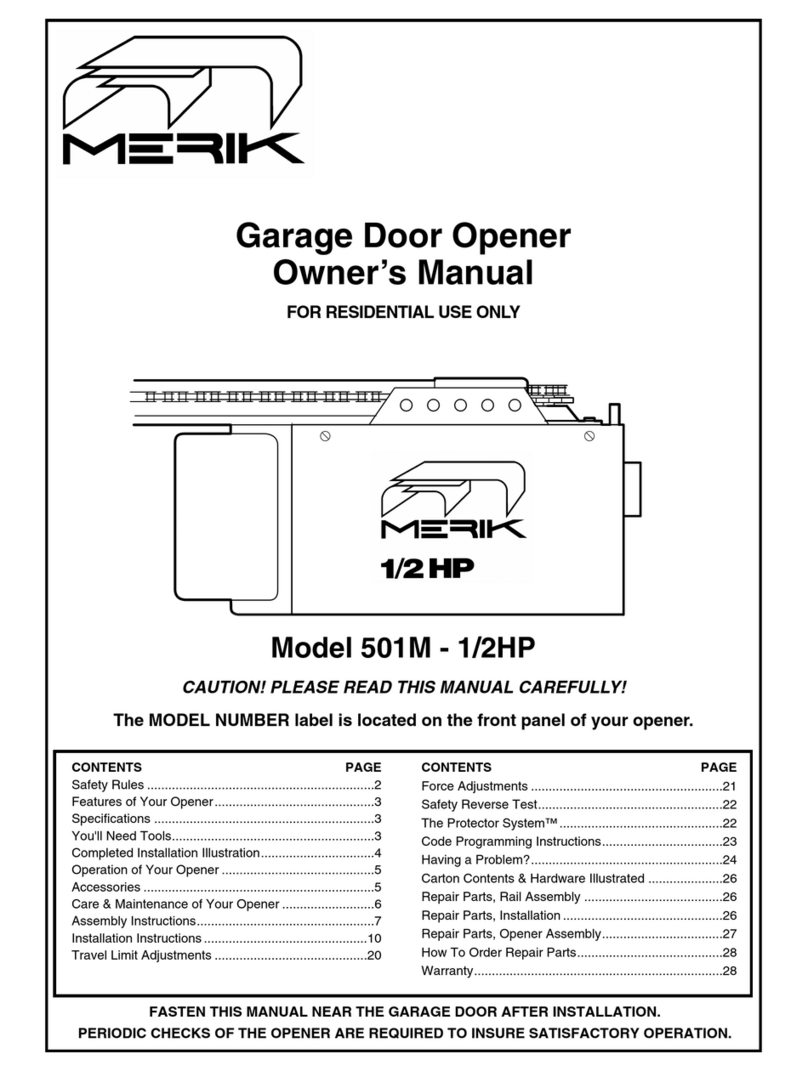
Merik
Merik 501M-1/2HP User manual

Merik
Merik 511MM FS2 User manual
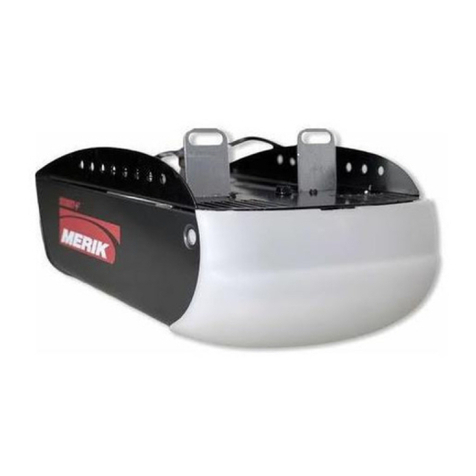
Merik
Merik Security+ 711MD User manual
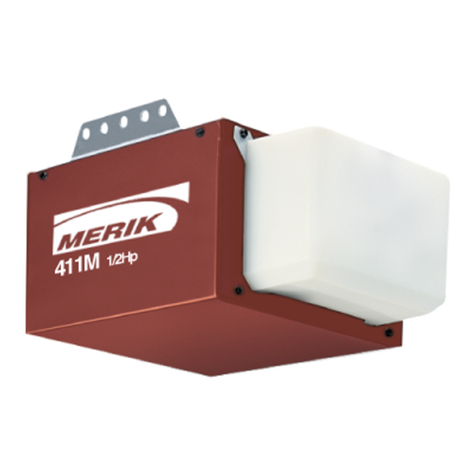
Merik
Merik Security+ 411M User manual
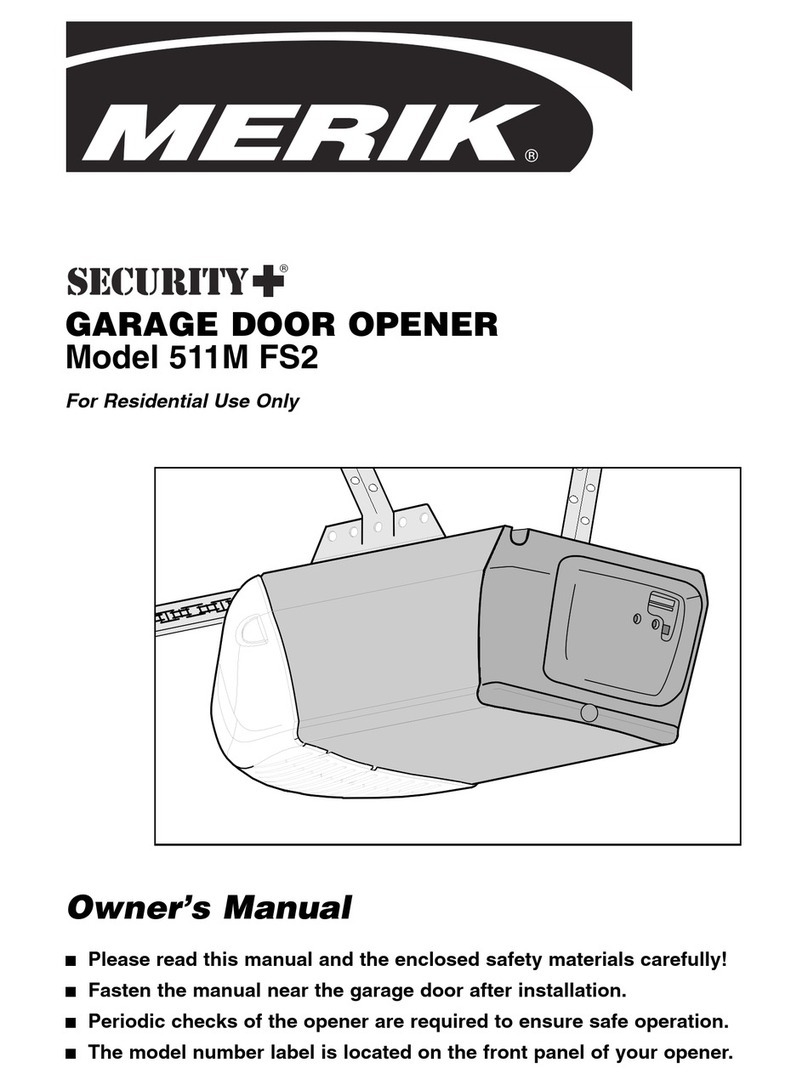
Merik
Merik 511M FS2 User manual
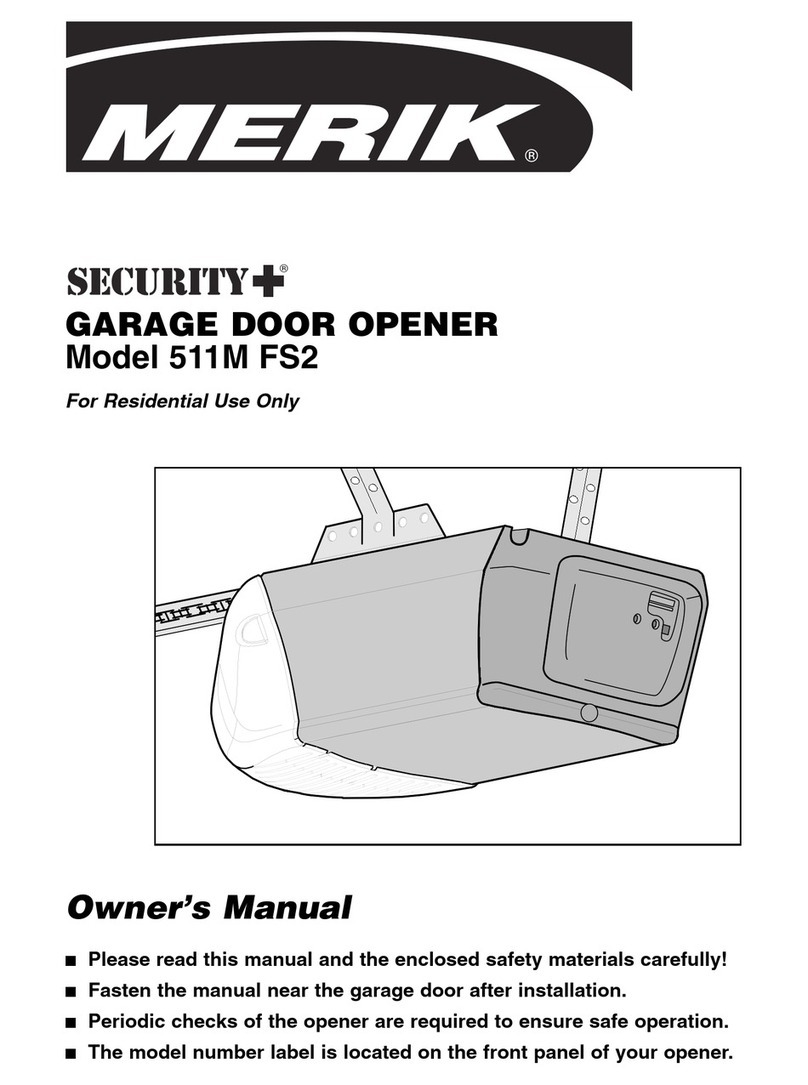
Merik
Merik 511M FS2 User manual

Merik
Merik 350 H User manual
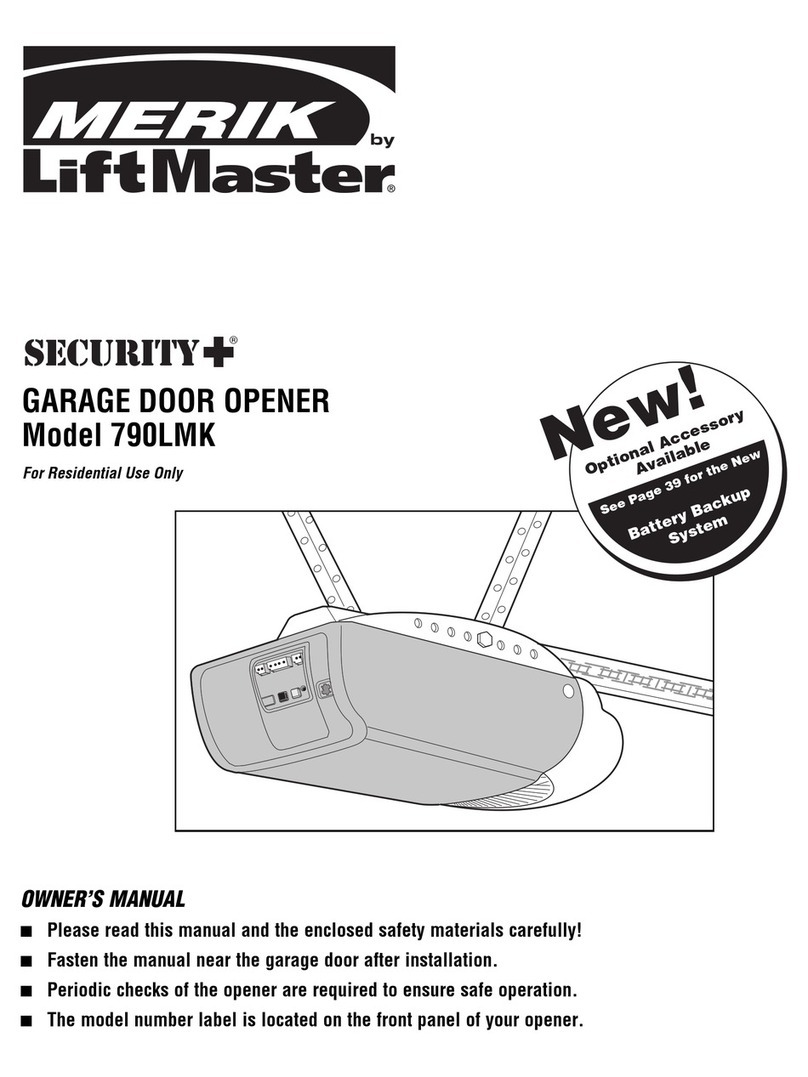
Merik
Merik 790LMK User manual
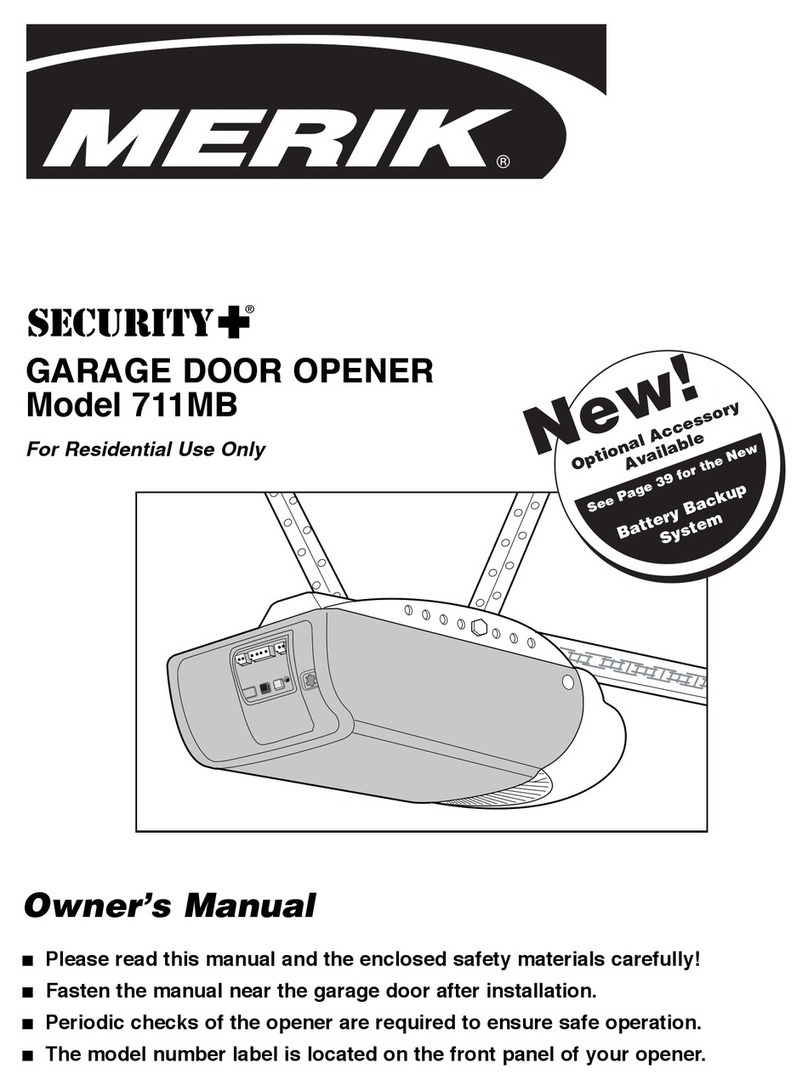
Merik
Merik 711MB User manual
Popular Garage Door Opener manuals by other brands

Serai
Serai MT/B6 installation manual
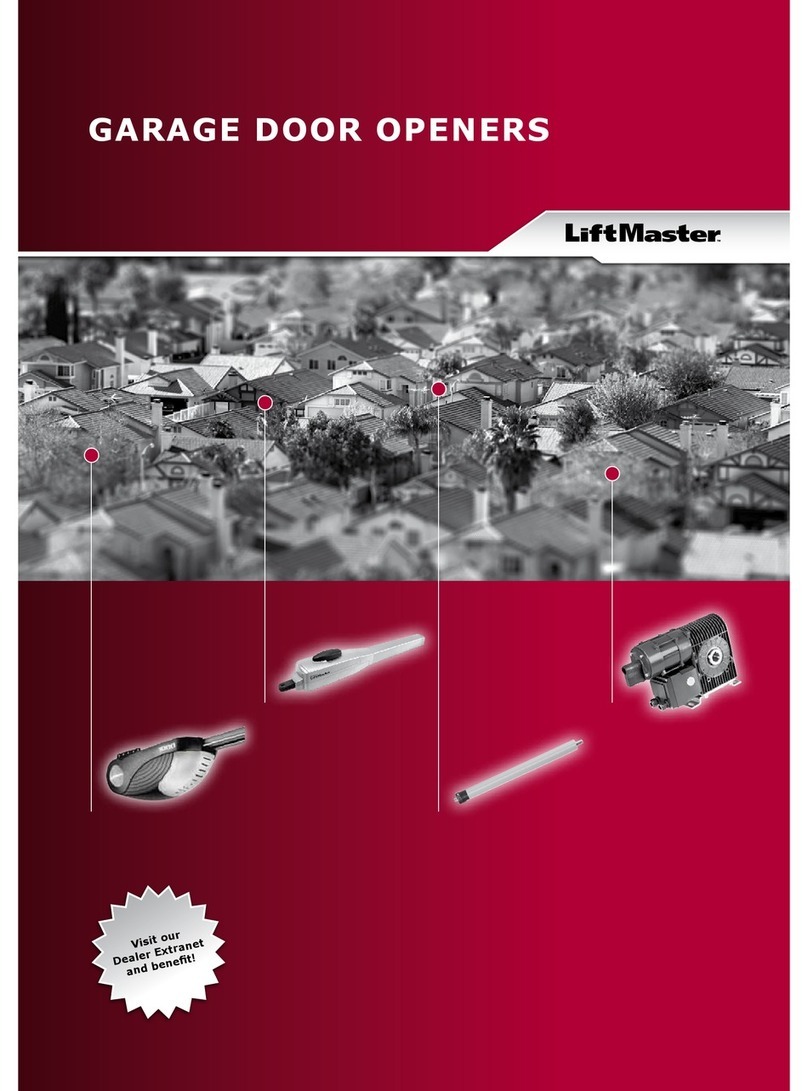
Chamberlain
Chamberlain LiftMaster LM800A-2 Technical data
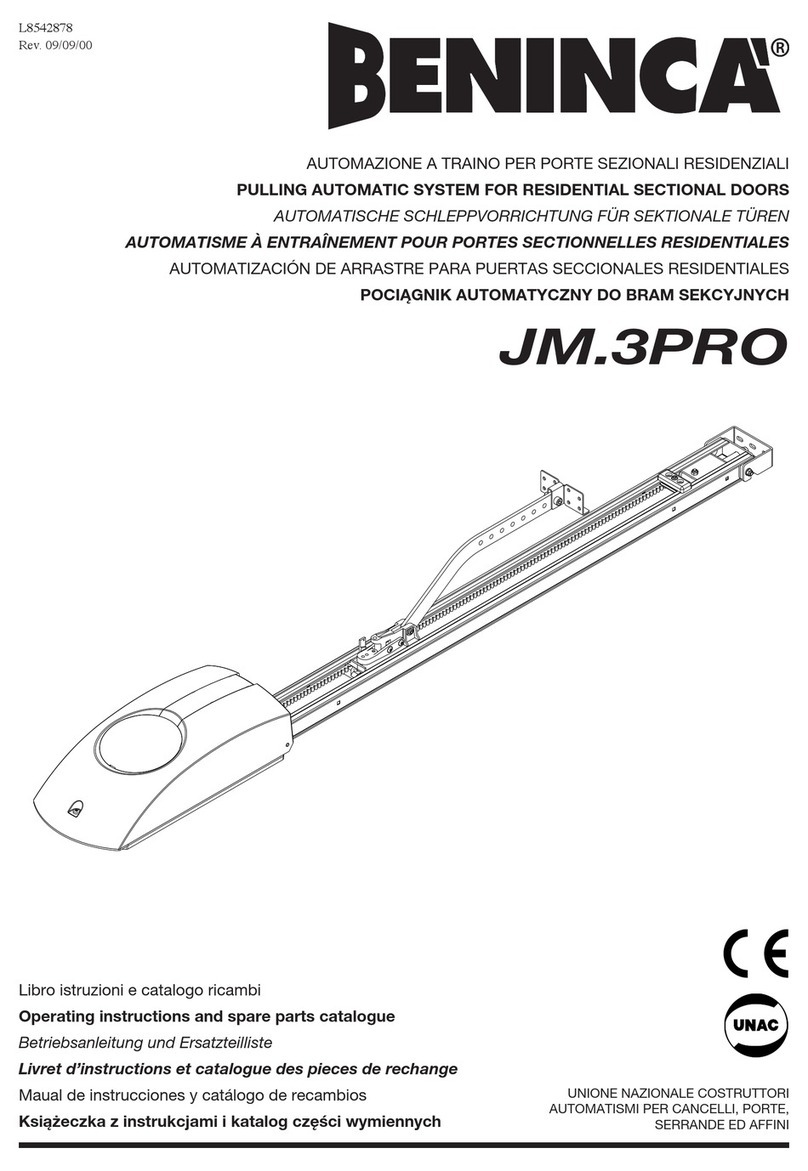
Beninca
Beninca JM.3PRO Operating instructions and spare parts catalogue
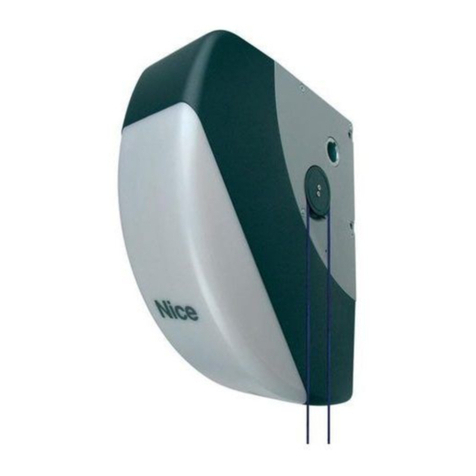
Nice
Nice SO2000 instructions
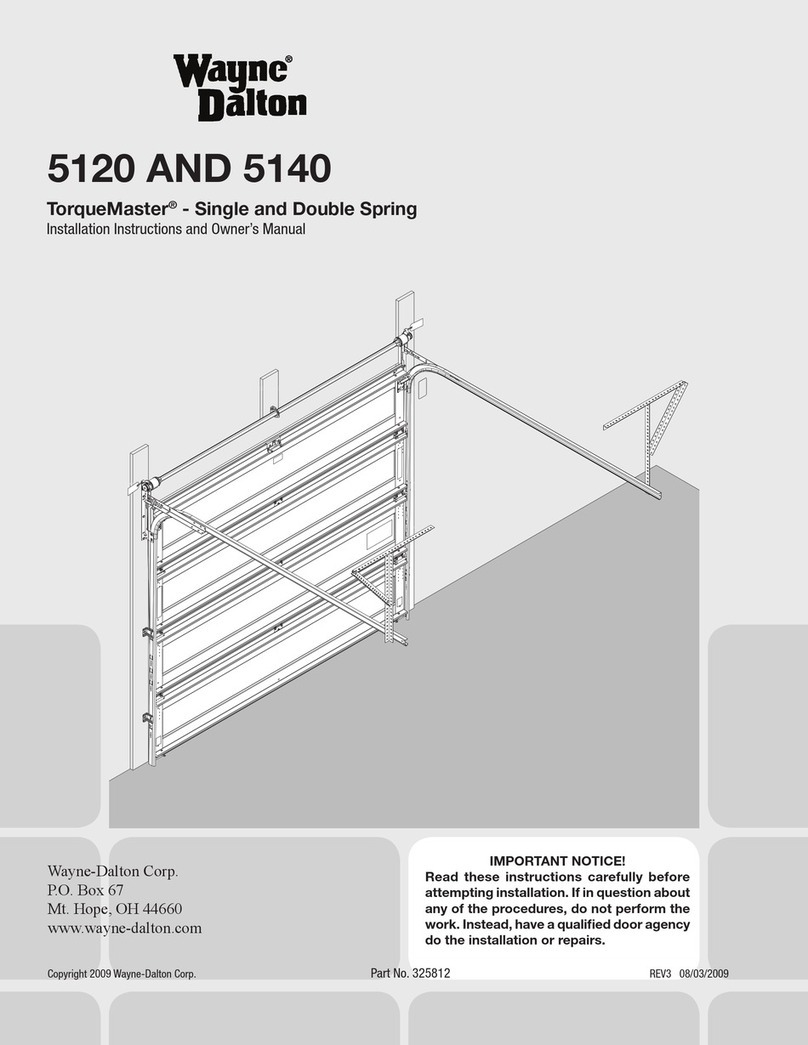
Wayne-Dalton
Wayne-Dalton TORQUEMASTER 5140 Installation instructions and owner's manual
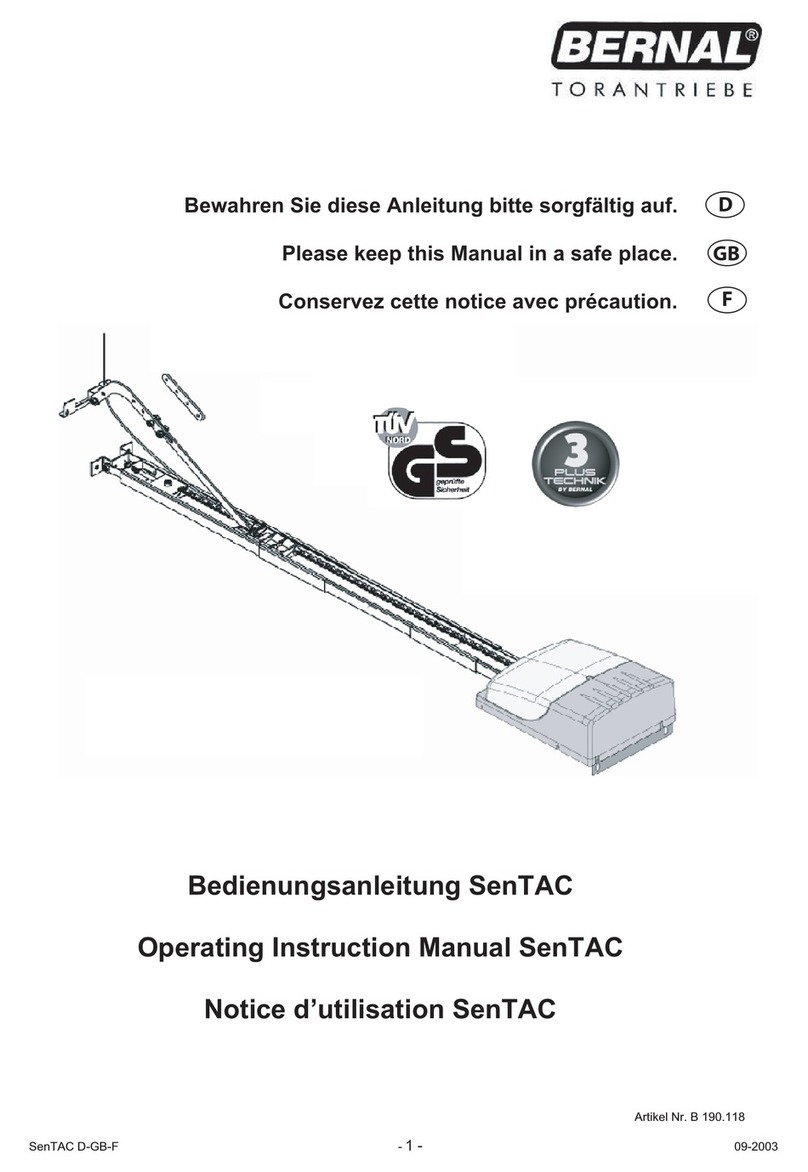
Bernal
Bernal SenTAC Operation & instruction manual


